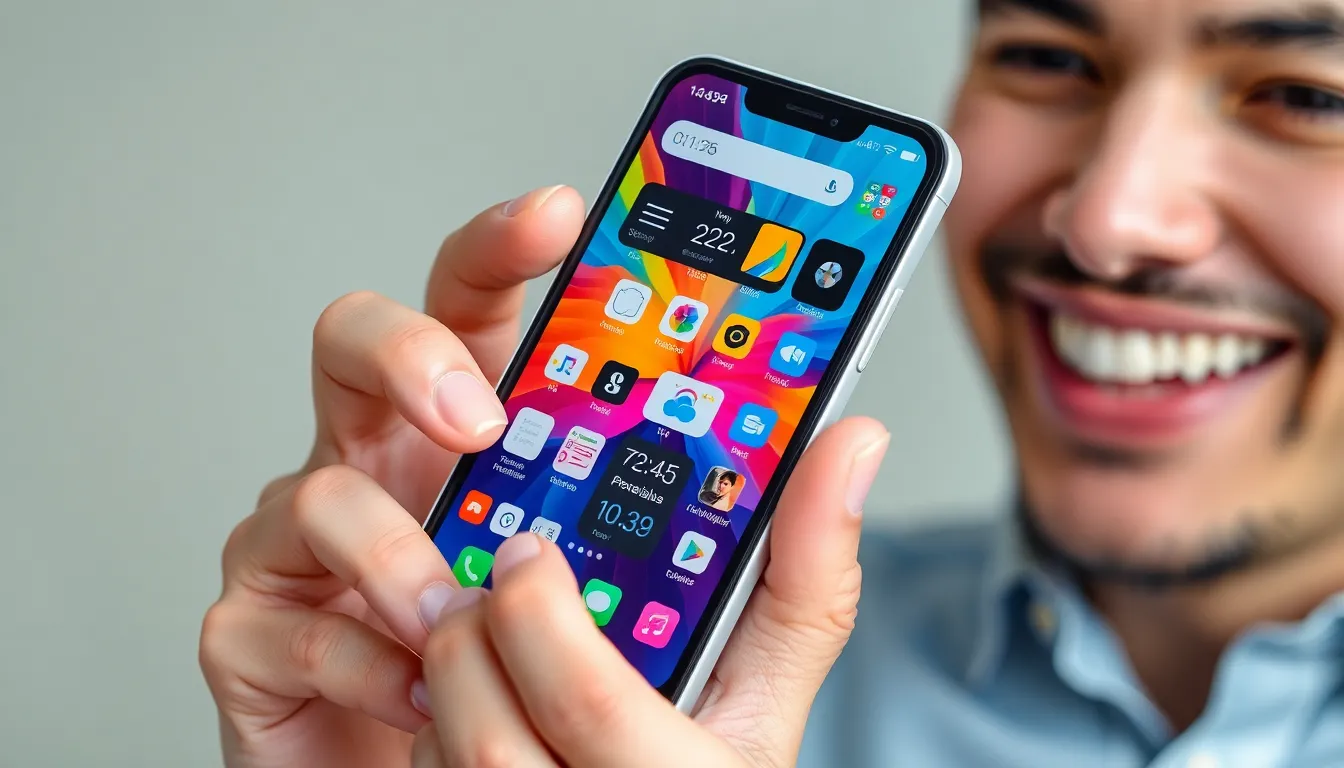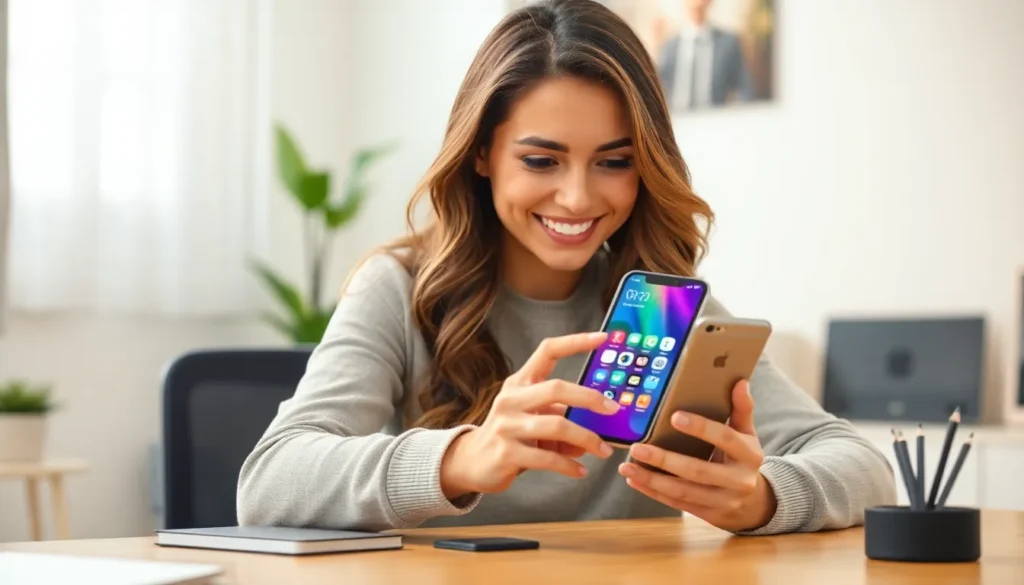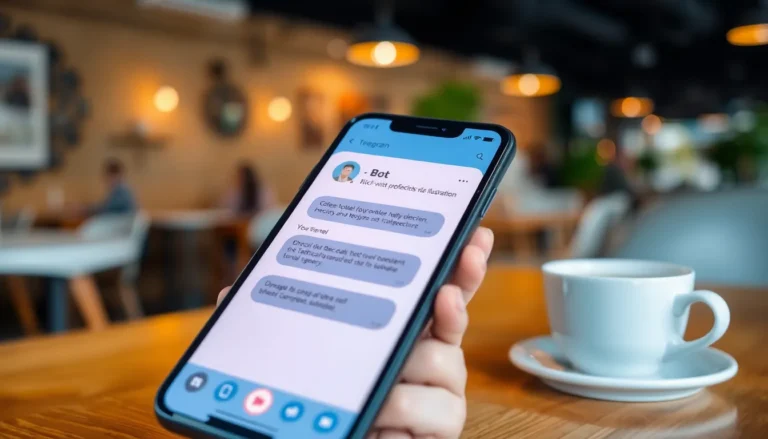In a world where smartphones have become extensions of ourselves, personalization features are the secret sauce that makes each device uniquely yours. Why settle for a generic interface when you can deck out your screen with vibrant wallpapers, quirky widgets, and ringtones that make your friends question your taste in music? From customizing app layouts to choosing the perfect font for your texts, the possibilities are endless.
Table of Contents
ToggleOverview of Smartphone Personalization Features
Smartphone personalization features enable users to tailor their devices to match personal preferences. These adjustments enhance user satisfaction and engagement. Wallpaper selection allows for visual expression, providing an immediate sense of individuality. Users can choose from a variety of images, from personal photos to abstract designs.
Widgets serve as another vital aspect of personalization. They offer practical information at a glance and allow users to access frequently used apps more efficiently. Options for widget sizes and styles facilitate a unique home screen experience tailored to specific needs.
Ringtones play an essential role in the customization process. Users can assign distinctive sounds for calls, messages, and notifications. This feature not only adds personal flair but also helps identify incoming alerts without needing to look at the screen.
App layouts contribute significantly to how users interact with their devices. Organizing apps into folders or customizing their arrangement enhances usability. Certain smartphones even enable dynamic app icons that change based on user preferences.
Font selection offers another layer of personalization. Users can choose different styles and sizes to make reading more comfortable and visually appealing. Adjusting font settings can transform the overall aesthetic of a smartphone.
Lastly, themes can completely change the look and feel of the device. Users often select themes that reflect their personality, from minimalist designs to vibrant collections. These comprehensive personalization options ensure each smartphone becomes an extension of the user’s identity.
Importance of Personalization in Smartphones

Personalization in smartphones significantly enhances the overall user experience. Users enjoy tailored interactions that suit their individual preferences and needs.
Enhancing User Experience
Smartphone personalization improves usability. It allows users to organize app layouts, ensuring easy access to frequently used applications. Widgets provide timely information at a glance, enhancing functionality and streamlining tasks. Selecting customized ringtones allows users to identify alerts without checking their devices, saving time and effort. Background wallpapers contribute to the aesthetic appeal, creating an inviting visual atmosphere. Personalization increases overall satisfaction, making devices feel more intuitive and user-friendly.
Reflecting Personal Style
Smartphones serve as extensions of one’s identity. Customizing themes helps users express their unique personalities and taste. Personal styles manifest through different font selections, allowing for both comfort in reading and visual appeal. Users can choose wallpapers that resonate with their interests or hobbies, such as nature scenes or favorite characters. Altering ringtones adds another layer of personal touch, reflecting individual preferences in sound. Emphasizing personal style through these features fosters a deeper emotional connection between users and their devices.
Types of Smartphone Personalization Features
Smartphone personalization features enhance user experience by allowing customization options that reflect individual preferences and styles. These features increase satisfaction, ensuring each device resonates with its owner.
Home Screen Customization
Home screen customization lets users create a unique interface that fits their needs. Users can select specific wallpapers, adjust widget sizes, and rearrange app icons. Functionality improves as frequently used apps become easily accessible. Personalized shortcuts save time and streamline interactions, making the device feel intuitive. Vibrant backgrounds can energize the home screen, while personalized widgets provide essential information at a glance. Such versatility transforms a standard phone into a personal dashboard.
App Arrangement and Folders
App arrangement and folders allow users to organize their applications for easy access. By creating folders, they can group similar apps together, simplifying navigation. Users can position essential apps on the home screen or within folders for quick access. Custom labels help identify folders, enhancing usability even further. Organized layouts reduce clutter and enhance efficiency when searching for apps. As a result, a well-arranged home screen promotes a smoother user experience.
Themes and Wallpapers
Themes and wallpapers play a significant role in smartphone personalization. Users can select from a variety of themes that alter colors, icon styles, and overall aesthetics. This feature creates a cohesive appearance that aligns with personal style. Wallpapers add a touch of creativity, showcasing favorite images, artwork, or patterns. Customization options abound, enabling users to express their individuality and preferences. A thoughtfully chosen theme or wallpaper can elevate the device’s appeal, turning a smartphone into a statement piece.
Advanced Personalization Options
Smartphones offer extensive personalization options that enhance usability and align with individual lifestyles. These advanced features cater to diverse needs, emphasizing uniqueness and functionality.
Custom Ringtones and Notifications
Custom ringtones and notification sounds empower users to personalize alerts. Individuals can select tones that resonate with their preferences or even create unique sounds for specific contacts. Doing so enables easy identification of calls and notifications without needing to glance at the screen. Many smartphones also support the option to adjust the volume and vibration settings for different alerts, adding another layer of customization. This feature not only promotes user enjoyment but also improves overall interaction with the device.
Accessibility Features
Accessibility features ensure smartphones cater to users with varying needs. Options include screen readers for the visually impaired and voice commands for hands-free operation. Customizable font sizes and color contrasts enhance visibility for different users. Additional features like magnification gestures and hearing aid compatibility support a wider range of users. These adaptations allow everyone to enjoy a more inclusive smartphone experience, reinforcing the importance of personalization for all.
Smartphone personalization features play a crucial role in enhancing user experience. By allowing users to tailor their devices to fit their unique styles and preferences, these features foster a deeper emotional connection with technology. Customizing wallpapers, widgets, and ringtones transforms a standard smartphone into a personal companion that reflects individuality.
The ability to organize apps and select themes ensures that each interaction is not only functional but also enjoyable. Furthermore, accessibility options highlight the importance of inclusivity, making smartphones adaptable for everyone. As technology continues to evolve, the significance of personalization will only grow, empowering users to create a device that truly feels like their own.










